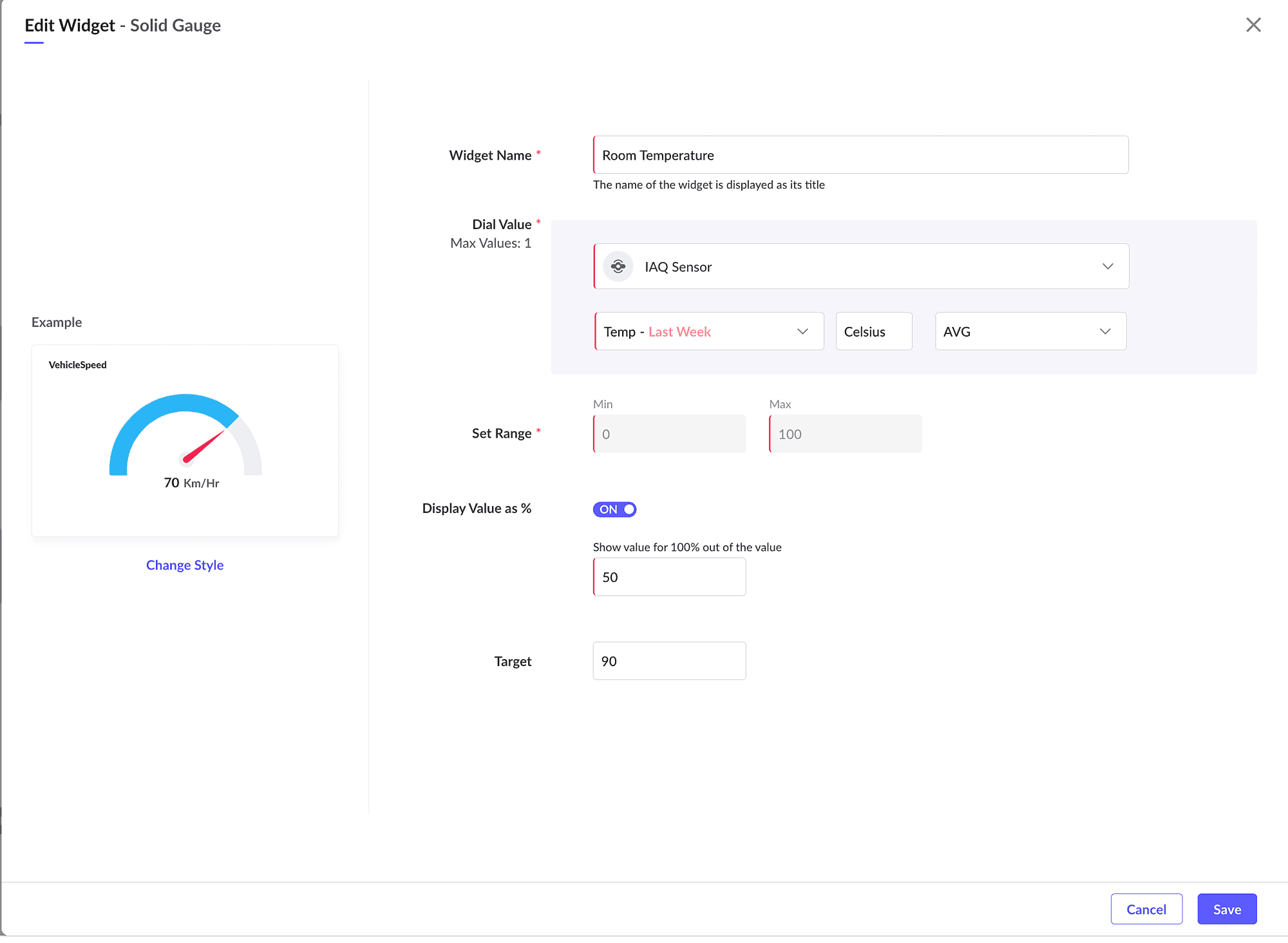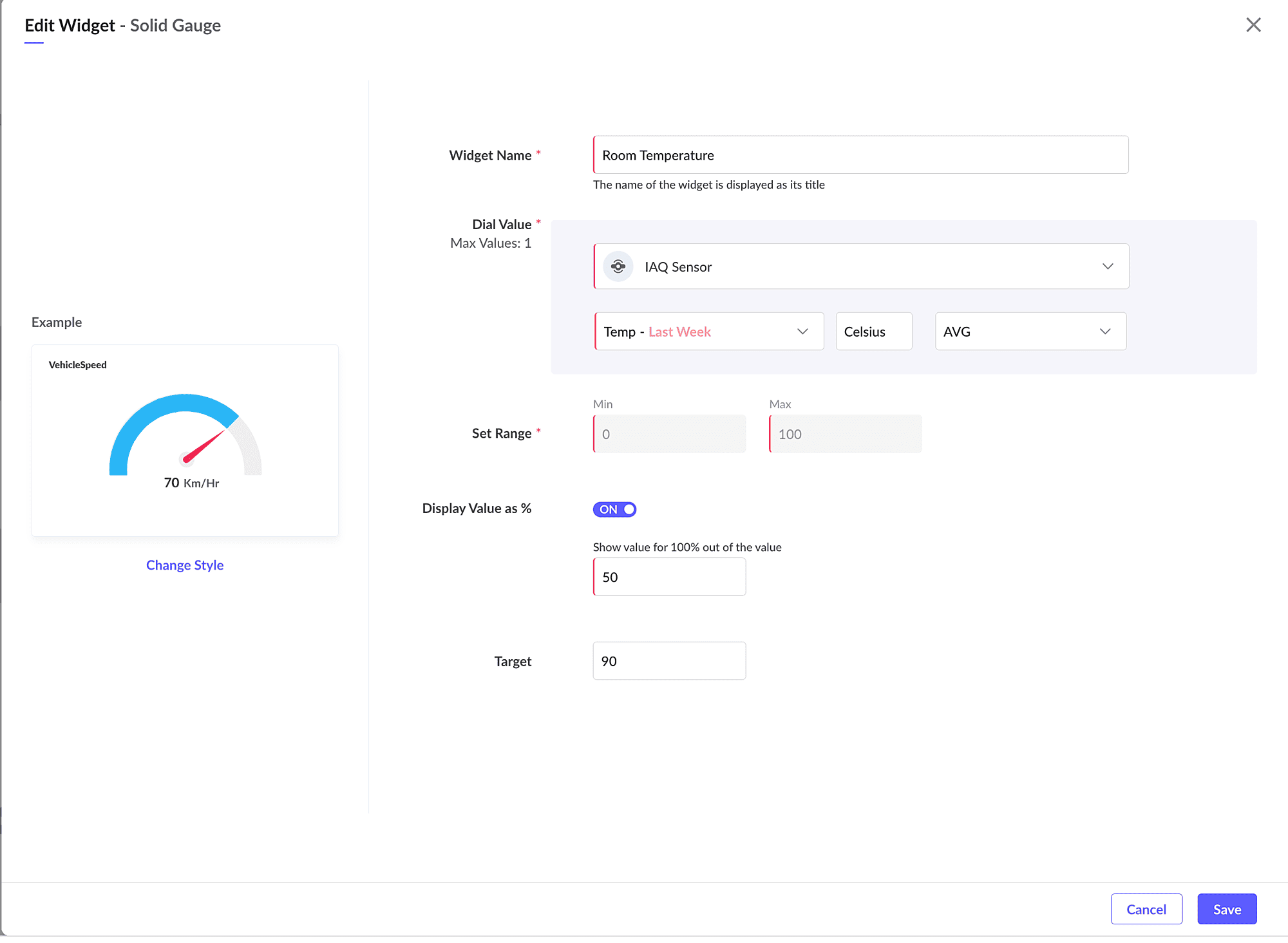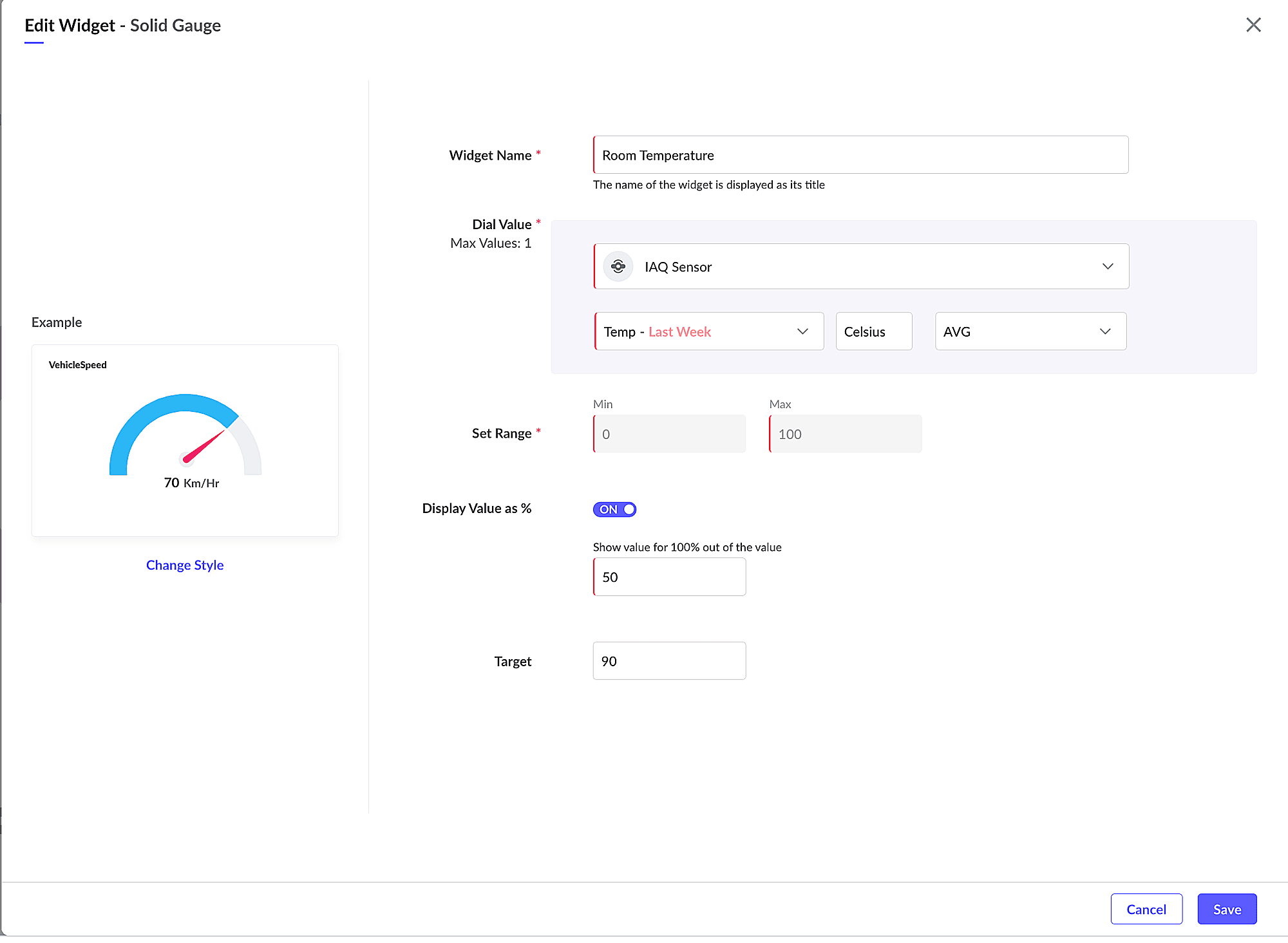Understanding Dial Widgets
Dial type widgets are used to display the value of a property with a pointer on a circular dial. You can construct different styles of dial widgets. Simple dial widgets can be configured to display a reading using a pointer against a set target, and advanced widgets can be configured to display a reading against colored ranges on the dial for easy performance monitoring.
All the Dial charts can be converted to any of its compatible formats.
The different styles of dials and their short descriptions are provided below:
Solid Gauge Dial
This style is used to display a single property value using a pointer on a colored half dial. You can configure the property to be plotted and the minimum and maximum range for the dial. You can also set the target value indication. This will help to easily visualize if the value is below or above the target value.
Image: Solid Gauge Dial displaying the COP for a day
To create a Solid Gauge style dial:
1. Access the End User Application.
2. In the dashboard view, click Actions > Edit Layout to invoke the dashboard builder.
3. Click on Dials in the Add Widget Components section in the left frame.
4. Select Historical or Realtime option on top.
- Historical to display collected stored data
- Realtime to display live data of a datapoint.
5. Select Solid Gauge Dial in the right slide window.
6. Click Proceed to display the Add Widget screen.
7. Provide the name/title for your widget.

8. Select the module (i.e. Asset, Device, Locations, System Modules, or Custom Modules) from the Measure drop down list for which you want to display the data. The module selection can be further fine-tuned using the filter option.
9. Select the Count, Field, or Datapoint for the selected module or model. The configure count/field/datapoint is displayed in the drop down list.
- Count - will display the total count of the instances of the selected model.
- Field - will display the field value. Along with the field, the aggregate based on which you want to display the data must be selected.
- Datapoint - will display the calculated value for the datapoint. Along with the datapoint, the time frame, unit, and aggregate based on which you want to display the data must be selected.
10. Provide the range for the dial.
If the values for the property are consistently smaller or higher values, it is recommended to modify the min. and max. values. For example, if the usual temperature range in a region is between 20 and 40 and there is no possibility of higher values, the min. and max. range can be set to 0 and 50.
If the values for the property are consistently smaller or higher values, it is recommended to modify the min. and max. values. For example, if the usual temperature range in a region is between 20 and 40 and there is no possibility of higher values, the min. and max. range can be set to 0 and 50.
11. Set the "Display Value as %" to ON if you want to display the value for a percentage.
If the percentage of a value will provide a better understanding, it is recommended to use the Display Value as % option. For example if the capacity of the monitored water tank is 2000 Lts, you can use the percentage option to display 75% full when the level reaches 1500 Lts.
If the percentage of a value will provide a better understanding, it is recommended to use the Display Value as % option. For example if the capacity of the monitored water tank is 2000 Lts, you can use the percentage option to display 75% full when the level reaches 1500 Lts.
12. Provide the target value. This will draw a threshold line indicator.
13. Click Create.
Semi Dial
This style is used to display a property reading or a value using a pointer on a colored half dial with an indicator scale. You can configure the property to be plotted and the minimum and maximum range for the dial. You can also set the target value indication. This will help you to easily visualize if the value is below or above the target value.
To create a Semi Dial style dial:
1. Access the End User Application.
2. In the dashboard view, click Actions > Edit Layout to invoke the dashboard builder.
3. Click on Dials in the Add Widget Components section in the left frame.
4. Select Historical or Realtime option on top.
- Historical to display collected stored data
- Realtime to display live data of a datapoint.
5. Select Semi Dial in the right slide window.
6. Click Proceed to display the Add Widget screen.
7. Provide the name/title for your widget.

8. Select the module (i.e. Asset, Device, Locations, System Modules, or Custom Modules) from the Measure drop down list for which you want to display the data. The module selection can be further fine-tuned using the filter option. Refer to the Add Filter section for further details.
9. Select the Count, Field, or Datapoint for the selected module or model. The configure count/field/datapoint is displayed in the drop down list.
- Count - will display the total count of the instances of the selected model.
- Field - will display the field value. Along with the field, the aggregate based on which you want to display the data must be selected.
- Datapoint - will display the calculated value for the datapoint. Along with the datapoint, the time frame, unit, and aggregate based on which you want to display the data must be selected.
10. Provide the range for the dial. By default, the range is set to a minimum of 0 and a maximum of 100 by default.
If the values for the property are consistently smaller or higher values, it is recommended to modify the min. and max. values. For example, if the usual temperature range in a region is between 20 and 40 and there is no possibility of higher values, the min. and max. range can be set to 0 and 50.
If the values for the property are consistently smaller or higher values, it is recommended to modify the min. and max. values. For example, if the usual temperature range in a region is between 20 and 40 and there is no possibility of higher values, the min. and max. range can be set to 0 and 50.
11. Set the "Display Value as %" to ON if you want to display the value for a percentage.
If the percentage of a value will provide a better understanding, it is recommended to use the Display Value as % option. For example if the capacity of the monitored water tank is 2000 Lts, you can use the percentage option to display 75% full when the level reaches 1500 Lts.
12. Provide the target value. This will draw a threshold line indicator.
13. Click Create.
Full Dial
This style is used to display a property reading or a value using a pointer on a colored full dial with an indicator scale. You can configure the property to be plotted and the minimum and maximum range for the dial. You can also set the target value indication. This will help to easily visualize if the value is below or above the target value.
To create a Full Dial style widget:
1. Access the End User Application.
2. In the dashboard view, click Actions > Edit Layout to invoke the dashboard builder.
3. Click on Dials in the Add Widget Components section in the left frame.
4. Select Historical or Realtime option on top.
- Historical to display collected stored data
- Realtime to display live data of a datapoint.
5. Select Full Dial in the right slide window.
6. Click Proceed to display the Add Widget screen.
7. Provide the name/title for your widget.
8. Select the module (i.e. Asset, Device, Locations, System Modules, or Custom Modules) from the Measure drop down list for which you want to display the data. The module selection can be further fine-tuned using the filter option. Refer to the Add Filter section for further details.
9. Select the Count, Field, or Datapoint for the selected module or model. The configure count/field/datapoint is displayed in the drop down list.
Count - will display the total count of the instances of the selected model.
Field - will display the field value. Along with the field, the aggregate based on which you want to display the data must be selected.
Datapoint - will display the calculated value for the datapoint. Along with the datapoint, the time frame, unit, and aggregate based on which you want to display the data must be selected.
10. Provide the range for the dial. By default, the range is set to a minimum of 0 and a maximum of 100 by default.
If the values for the property are consistently smaller or higher values, it is recommended to modify the min. and max. values. For example, if the usual temperature range in a region is between 20 and 40 and there is no possibility of higher values, the min. and max. range can be set to 0 and 50.
If the values for the property are consistently smaller or higher values, it is recommended to modify the min. and max. values. For example, if the usual temperature range in a region is between 20 and 40 and there is no possibility of higher values, the min. and max. range can be set to 0 and 50.
11. Set the "Display Value as %" to ON if you want to display the value for a percentage.
If the percentage of a value will provide a better understanding, it is recommended to use the Display Value as % option. For example if the capacity of the monitored water tank is 2000 Lts, you can use the percentage option to display 75% full when the level reaches 1500 Lts.
If the percentage of a value will provide a better understanding, it is recommended to use the Display Value as % option. For example if the capacity of the monitored water tank is 2000 Lts, you can use the percentage option to display 75% full when the level reaches 1500 Lts.
12. Provide the target value. This will draw a threshold line indicator.
13. Click Create.
Progress Dial
This style is used to display a property reading or a value using a pointer on a colored full dial which is divided into multiple ranges to indicate the progress made by the value. You can configure the property to be plotted and the minimum and maximum range along with the multiple ranges. This will help you to easily visualize the progress.
To create a Progress Dial style widget:
1. Access the End User Application.
2. In the dashboard view, click Actions > Edit Layout to invoke the dashboard builder.
3. Click on Dials in the Add Widget Components section in the left frame.
4. Select Historical or Realtime option on top.
Historical to display collected stored data
Realtime to display live data of a datapoint.
5. Select Progress Dial in the right slide window.
6. Click Proceed to display the Add Widget screen.
7. Provide the name/title for your widget.
8. Select the module (i.e. Asset, Device, Locations, System Modules, or Custom Modules) from the Measure drop down list for which you want to display the data. The module selection can be further fine-tuned using the filter option. Refer to the Add Filter section for further details.
9. Select the Count, Field, or Datapoint for the selected module or model. The configure count/field/datapoint is displayed in the drop down list.
- Count - will display the total count of the instances of the selected model.
- Field - will display the field value. Along with the field, the aggregate based on which you want to display the data must be selected.
- Datapoint - will display the calculated value for the datapoint. Along with the datapoint, the time frame, unit, and aggregate based on which you want to display the data must be selected.
10. Provide the range for the dial. By default, the range is set to a minimum of 0 and a maximum of 100 by default.
If the values for the property are consistently smaller or higher values, it is recommended to modify the min. and max. values. For example, if the usual temperature range in a region is between 20 and 40 and there is no possibility of higher values, the min. and max. range can be set to 0 and 50.
If the values for the property are consistently smaller or higher values, it is recommended to modify the min. and max. values. For example, if the usual temperature range in a region is between 20 and 40 and there is no possibility of higher values, the min. and max. range can be set to 0 and 50.
11. Set the "Display Value as %" to ON if you want to display the value for a percentage.
If the percentage of a value will provide a better understanding, it is recommended to use the Display Value as % option. For example if the capacity of the monitored water tank is 2000 Lts, you can use the percentage option to display 75% full when the level reaches 1500 Lts.
If the percentage of a value will provide a better understanding, it is recommended to use the Display Value as % option. For example if the capacity of the monitored water tank is 2000 Lts, you can use the percentage option to display 75% full when the level reaches 1500 Lts.
12. Configure the color coding for the different ranges of the dial.
13. Provide the target value. This will draw a threshold line indicator.
14. Click Create.
Full Circle Dial
This style is used to display the value on a colored complete full circle dial. You can set the target value indication, which will be displayed at the center of the hollow circle.
To create a Full Circle Dial style widget:
1. Access the End User Application.
2. In the dashboard view, click Actions > Edit Layout to invoke the dashboard builder.
3. Click on Dials in the Add Widget Components section in the left frame.
4. Select Historical or Realtime option on top.
- Historical to display collected stored data
- Realtime to display live data of a datapoint.
5. Select Full Circle Dial in the right slide window.
6. Click Proceed to display the Add Widget screen.
7. Provide the name/title for your widget.

8. Select the module (i.e. Asset, Device, Locations, System Modules, or Custom Modules) from the Measure drop down list for which you want to display the data. The module selection can be further fine-tuned using the filter option. Refer to the Add Filter section for further details.
9. Select the Count, Field, or Datapoint for the selected module or model. The configure count/field/datapoint is displayed in the drop down list.
- Count - will display the total count of the instances of the selected model.
- Field - will display the field value. Along with the field, the aggregate based on which you want to display the data must be selected.
- Datapoint - will display the calculated value for the datapoint. Along with the datapoint, the time frame, unit, and aggregate based on which you want to display the data must be selected.
10. Provide the maximum limit for the dial.
11. Click Create.
Full Circle Dial - Multivalued
This style is used to display the value on a colored complete full circle dial. You can set the target value indication, which will be displayed at the center of the hollow circle.
Image: Full Circle Dial displaying Battery usage and Alarms count
To create a Full Circle Dial style widget:
1. Access the End User Application.
2. In the dashboard view, click Actions > Edit Layout to invoke the dashboard builder.
3. Click on Dials in the Add Widget Components section in the left frame.
4. Select Historical or Realtime option on top.
- Historical to display collected stored data
- Realtime to display live data of a datapoint.
5. Select Full Circle Dial in the right slide window.
6. Click Proceed to display the Add Widget screen.
7. Provide the name/title for your widget.
8. Select the module (i.e. Asset, Device, Locations, System Modules, or Custom Modules) from the Measure drop down list for which you want to display the data. The module selection can be further fine-tuned using the filter option. Refer to the Add Filter section for further details.
9. Select the Count, Field, or Datapoint for the selected module or model. The configure count/field/datapoint is displayed in the drop down list.
- Count - will display the total count of the instances of the selected model.
- Field - will display the field value. Along with the field, the aggregate based on which you want to display the data must be selected.
- Datapoint - will display the calculated value for the datapoint. Along with the datapoint, the time frame, unit, and aggregate based on which you want to display the data must be selected.
10. Click on the + icon to add more Measure. Up to a maximum of 3 dial values can be provided.
11. Click on Add Module Metric button if you want to add different modules & measures.
12. Click Create.
See Also
Zoho CRM Training Programs
Learn how to use the best tools for sales force automation and better customer engagement from Zoho's implementation specialists.
Zoho DataPrep Personalized Demo
If you'd like a personalized walk-through of our data preparation tool, please request a demo and we'll be happy to show you how to get the best out of Zoho DataPrep.
New to Zoho Writer?
You are currently viewing the help pages of Qntrl’s earlier version. Click here to view our latest version—Qntrl 3.0's help articles.
Zoho Sheet Resources
Zoho Forms Resources
New to Zoho Sign?
Zoho Sign Resources
New to Zoho TeamInbox?
Zoho TeamInbox Resources
New to Zoho ZeptoMail?
New to Zoho Workerly?
New to Zoho Recruit?
New to Zoho CRM?
New to Zoho Projects?
New to Zoho Sprints?
New to Zoho Assist?
New to Bigin?
Related Articles
Understanding Widgets
Widgets are the fundamental components of a dashboard, presenting vital statistics in intuitive formats within the Zoho IOT application. You can create various types of widgets, including cards, charts, custom fill, dials, image, tables, calendars, ...Understanding Image Widgets
Image type widgets are used to display the value of a property along with an appropriate image. You can choose from a list of styles such as Simple Image, Image with Metrics, Image with Comparison Metrics, and Image with String Metrics widgets. The ...Understanding Dashboards
A dashboard is the primary user interface in the Zoho IoT application, displaying vital monitored metrics of devices and assets within the IoT network. A well-designed dashboard serves as a health monitor for the network, showcasing both real-time ...Working with Widgets
Creating Widgets This section of the document provides an overview of creating and editing various types of widgets. The following are the ways to create & add widgets in a dashboard. When creating a new dashboard. Using the Actions > Add Widget ...Understanding Calendar Widgets
Calendar type widgets are utilized for setting up calendar-based views on the dashboard. Within these widgets, the metrics of a managed entity can be showcased date-wise for a given month. Such widgets prove highly beneficial when analyzing values on ...
New to Zoho LandingPage?
Zoho LandingPage Resources















